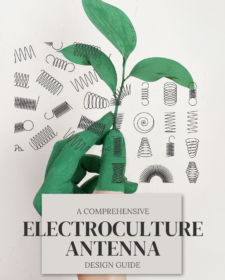Welcome to Electroculture Magazine, your ultimate destination for all things electrifying in the world of agriculture! In this intriguing blog post, we explore the fascinating topic of “What is an Electroculture Antenna?” Prepare to embark on a journey of discovery as we unveil the secrets of this remarkable device. We’ll delve into its purpose, construction, and functioning, as well as its role in enhancing plant growth and productivity.
Join us as we unravel the science behind electroculture antennas and explore their potential to revolutionize the way we cultivate our crops. Get ready to unlock the power of this electrifying tool and unleash the full potential of your farming endeavors!
Introduction
The electroculture antenna, a tool that creates electromagnetic fields and is intended to be placed in a field or garden to encourage plant growth, is intended to be used in electroculture. The antenna normally consists of a metal rod or wire that is connected to an electrical source and can be supplied by a battery or solar panel. It is thought that the antenna’s creation of a faint electric field surrounding the plants stimulates their growth.
A device called an electroculture antenna is used to gather and disperse electrical energy from the atmosphere of the Earth into the soil. The growth of plants is then stimulated, increasing crop yields. Copper wire is often used to make electroculture antennae, which can either be buried in the ground or installed above ground.

According to the electroculture idea, for plants to grow and thrive, they require a specific amount of electrical energy. According to some theories, this energy aids plants’ ability to uptake nutrients from the soil, fend off pests and diseases, and produce more blossoms and fruit. It has been demonstrated that electroculture is effective at boosting crop yields for a number of crops, including cereals, fruits, and vegetables.
The best electroculture antenna for you will depend on the size of your garden and your budget. There are several different types of electroculture antennas available. While some straightforward antennas can be constructed at home using a few common components, others are more complicated and require installation by a professional.
Types of Electroculture Antennas
There are a number of different types of electroculture antennas available, each with its own advantages and disadvantages. Some of the most common types of electroculture antennas include:
- Spiral antennas: Spiral antennas are one of the most common types of electroculture antennas. They are relatively easy to make and install, and they are effective in a variety of soil types.
- Pyramid antennas: Pyramid antennas are another popular type of electroculture antenna. They are thought to be more effective than spiral antennas in certain soil types, such as clay soil.
- Coil antennas: Coil antennas are a more complex type of electroculture antenna, but they can be very effective in improving plant growth and increasing crop yields.
Buy Our Handcrafted Electroculture Anetnna Design eBook Now…
Features of Electroculture Antennas
Electroculture antennas typically consist of a metal rod or wire that is connected to an electrical source, such as a battery or solar panel. The antenna emits a weak electric field around the plants, which is believed to stimulate their growth. The strength of the electric field can vary depending on the type of antenna and the amount of power used.

Benefits of Electroculture Antennas
The potential benefits of using electroculture antennas in agriculture include:
- Increased plant growth: The use of electroculture antennas has been shown to stimulate plant growth and increase yield in some crops.
- Reduced use of fertilizers and pesticides: By enhancing the natural growth processes of plants, electroculture antennas can help reduce the need for synthetic fertilizers and pesticides, which can have harmful environmental impacts.
- Improved soil quality: Electrostatic agriculture can improve soil quality by increasing the availability of nutrients and enhancing soil structure.
- Water conservation: By promoting healthier plants, electroculture antennas can help reduce water usage in agriculture.
- Energy efficiency: Electroculture antennas can be powered by renewable energy sources such as solar panels, making them a more sustainable alternative to traditional agricultural practices.
Conclusion
Electroculture antennas are an intriguing technology that has the potential to revolutionize the world of farming. While more research is needed to fully understand their effectiveness, the benefits of electrostatic agriculture are clear. As the demand for sustainable agriculture practices continues to grow, electroculture antennas may become an increasingly important tool for farmers and researchers alike.
Get more accurate guidance from ELECTROCTURE TEXTBOOKS, choose your book by clicking below...











![Electroculture Bible: [7 IN 1] by Rick Croppield Electroculture Bible: [7 IN 1] by Rick Croppield](https://electroculturemagazine.com/wp-content/uploads/2023/08/B0C47Q56RC.01._SCLZZZZZZZ_SX500_-200x290.jpg)

![Electroculture Bible: [5 IN 1]: by Benjamin Foster Electroculture Bible: [5 IN 1]: by Benjamin Foster](https://electroculturemagazine.com/wp-content/uploads/2023/08/51XVYHHWHfL._SX384_BO1204203200_-200x290.jpg)

